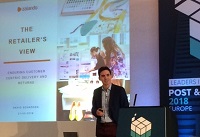Zalando will continue to roll out new delivery and returns services to improve customer experience as it transforms from an e-retailer into a broader European platform specialising in fashion and related products, and enters new markets, a top manager said this week.
The German-based company is now active in 15 European markets and aiming to enter two or three more this year, David Schröder, Senior Vice President Convenience (which includes logistics), told this week’s Leaders in Logistics Post & Parcel Europe conference in Berlin.
“We consider ourselves a technology company that sells fashion. We are transforming to a platform model and need brands to trade on our platforms,” he said. Zalando wants to increase its inventory to about one million SKUs “as fast as possible”, he noted.
In 2017, the company shipped a total of 90 million orders and, with a returns rate of about 50%, effectively generated about 135 million parcels for delivery.
Outlining the company’s strategy to an audience of some 200 international postal industry managers, suppliers and other stakeholders, Schröder said Zalando wanted to offer a ‘frictionless’ convenience experience to customers.
In terms of deliveries, he said: “There is a clear preference from customers for home delivery.” Alternative delivery locations are “not the right way” because “that is making our problems into the customer’s problem”.
Schröder highlighted Zalando’s new Returns on Demand service which he said has generated a very positive customer response. Customers can click on ‘Return’ in the Zalando app to tell the retailer “what, where and when” to pick up as a return item. Zalando then orders a courier to handle the collection. The company is working with local courier companies in 15 major cities at present to provide Returns on Demand and plans to extend it to more in future.
The Zalando Convenience chief told postal managers that the company was ready to cooperate in order to develop ‘customer-centric’ delivery solutions and wanted to offer “a much better returns experience”. He also urged them to “think API first” and integrate their delivery services into retailer apps “where customers spend time” rather than their own separate carrier apps.
Berlin-based Zalando has grown fast over the last decade from a start-up fashion e-retailer into a major European player active in 15 European markets (Austria, Belgium, Denmark, Finland, France, Germany, Italy, Luxembourg, the Netherlands, Norway, Spain, Sweden, Switzerland, Poland and the UK).
In 2017, the company increased revenues by over 23% to nearly €4.5 billion as the customer base grew to 23.1 million active customers and the average number of orders per active customer rose to 3.9, up from 3.5 in 2016. Zalando recorded an adjusted EBIT of €215.1 million in 2017, resulting in a margin of 4.8%.
This year Zalando expects to outpace the European online fashion market by growing revenues 20-25%, adding about €1 billion in revenues, and improving the adjusted EBIT to €220-270 million (or a margin of around 4-5%).
During 2018, the company will expand its assortment with new brands, launch a beauty category, enter two European markets adjacent to its existing markets, and focus on an increasingly personalised customer experience, providing each customer with their own personal Zalando shop.
Zalando is investing heavily to expand its logistics network and move from a centralised to a more regional structure in order to speed up deliveries. The company, which is known for offering free delivery and returns, aims to offer next-day deliveries to 75% of the European population by 2020.
At present, it has five centrally located fulfilment centres, with three in Germany (Erfurt, Mönchengladbach and Lahr) and two in Poland (Gryfino close to Szczecin and Gluchow close to Lodz). These are supported by smaller warehouses in Germany, northern Italy, France and Sweden with a focus on local customer needs.
This spring, the e-retailer will start building a Southern Europe fulfilment hub, covering 130,000 sqm, at Nogarole Rocca, close to Verona in northern Italy, and will double its existing fulfilment centre at Stradella, near Pavia, to about 40,000 sqm.
Capital expenditure in 2017 amounted to €243.9 million, excluding M&A, reflecting investments primarily into logistics infrastructure, including increased automation and in-house developed software. Capital expenditure in 2018 is expected to be around €350 million, excluding M&A, with a similar investment focus as 2017.










